Australia Taxation Law Question Answer 2022
VerifiedAdded on 2022/09/25
|10
|2034
|19
AI Summary
Contribute Materials
Your contribution can guide someone’s learning journey. Share your
documents today.
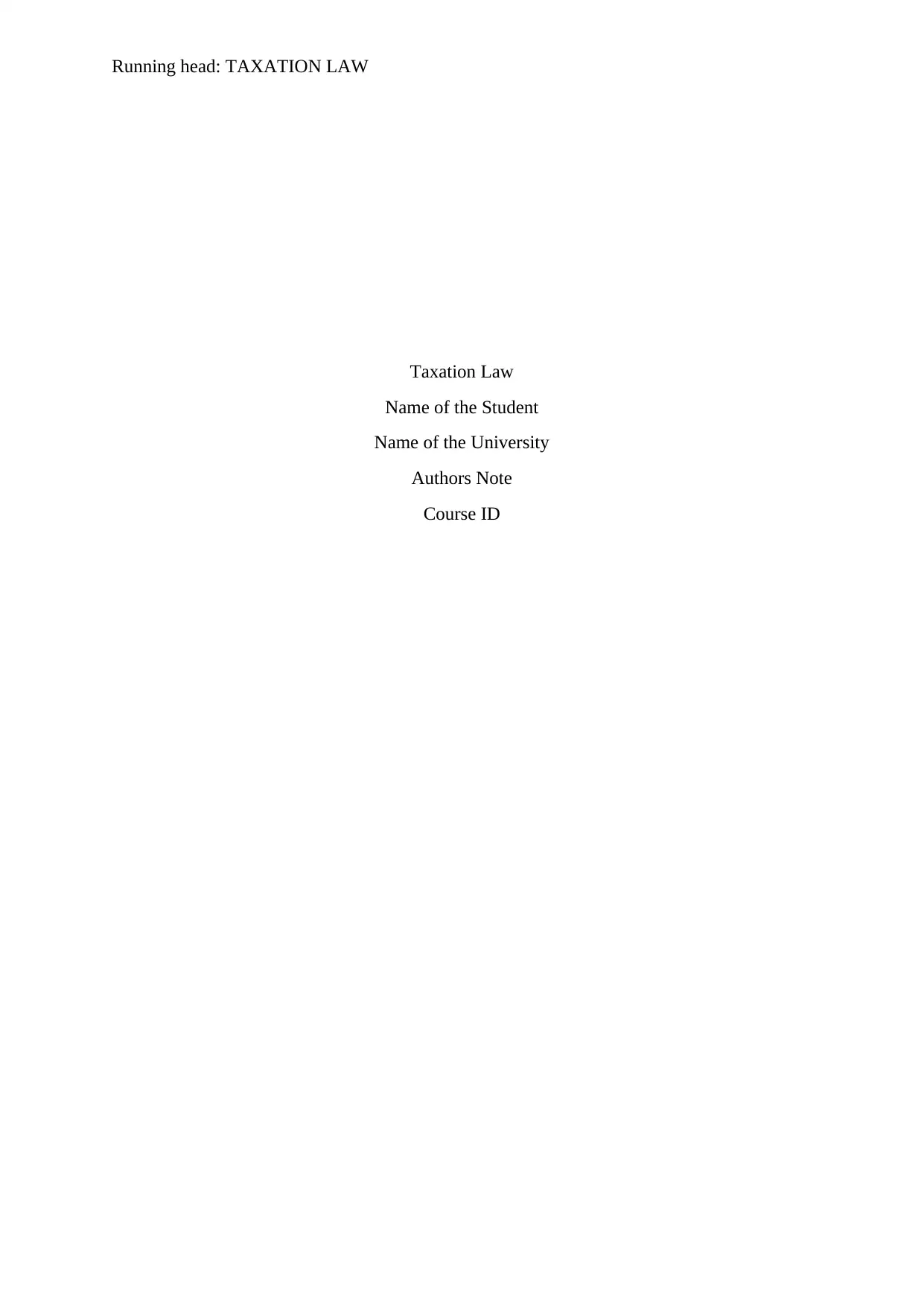
Running head: TAXATION LAW
Taxation Law
Name of the Student
Name of the University
Authors Note
Course ID
Taxation Law
Name of the Student
Name of the University
Authors Note
Course ID
Secure Best Marks with AI Grader
Need help grading? Try our AI Grader for instant feedback on your assignments.
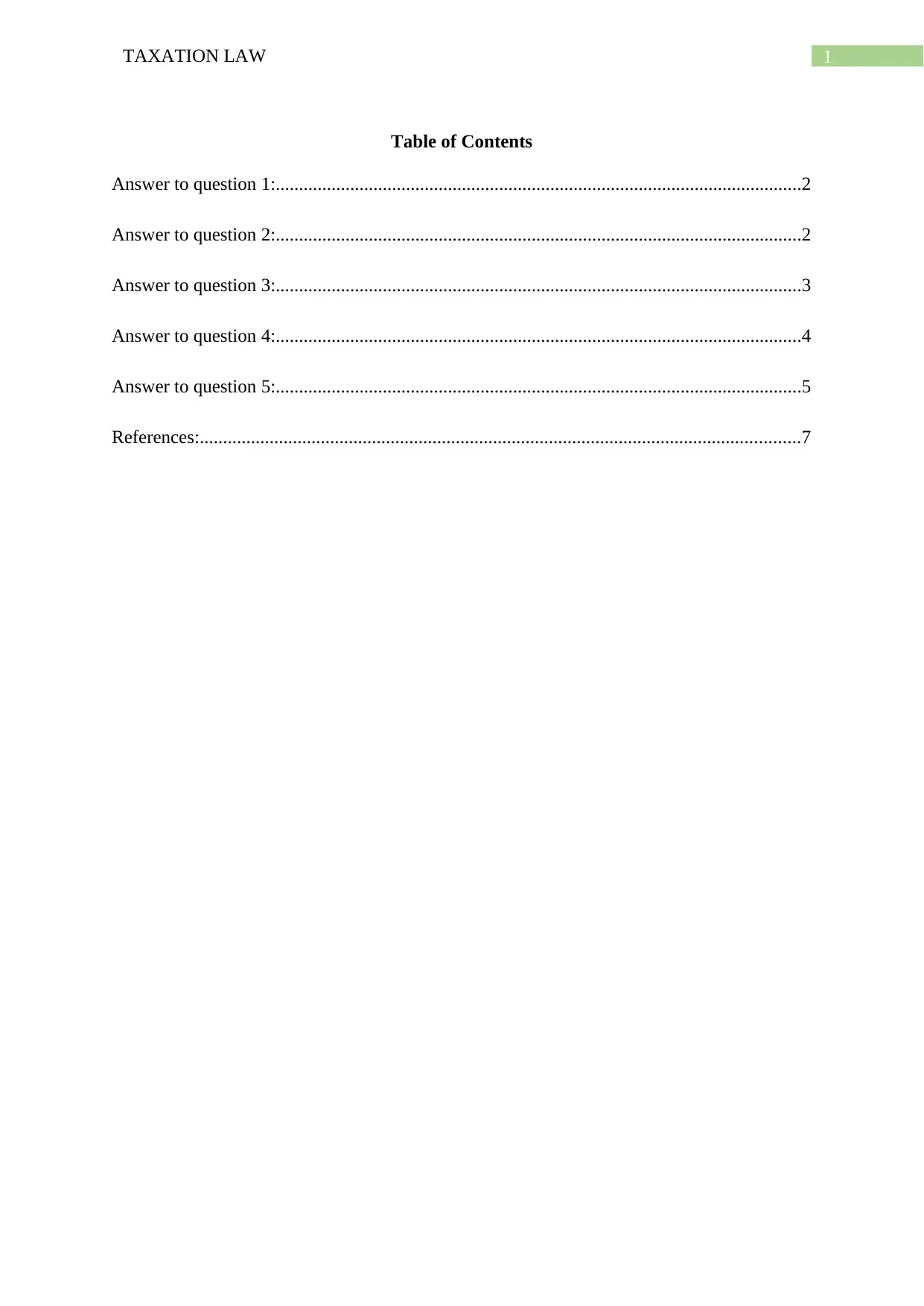
1TAXATION LAW
Table of Contents
Answer to question 1:.................................................................................................................2
Answer to question 2:.................................................................................................................2
Answer to question 3:.................................................................................................................3
Answer to question 4:.................................................................................................................4
Answer to question 5:.................................................................................................................5
References:.................................................................................................................................7
Table of Contents
Answer to question 1:.................................................................................................................2
Answer to question 2:.................................................................................................................2
Answer to question 3:.................................................................................................................3
Answer to question 4:.................................................................................................................4
Answer to question 5:.................................................................................................................5
References:.................................................................................................................................7
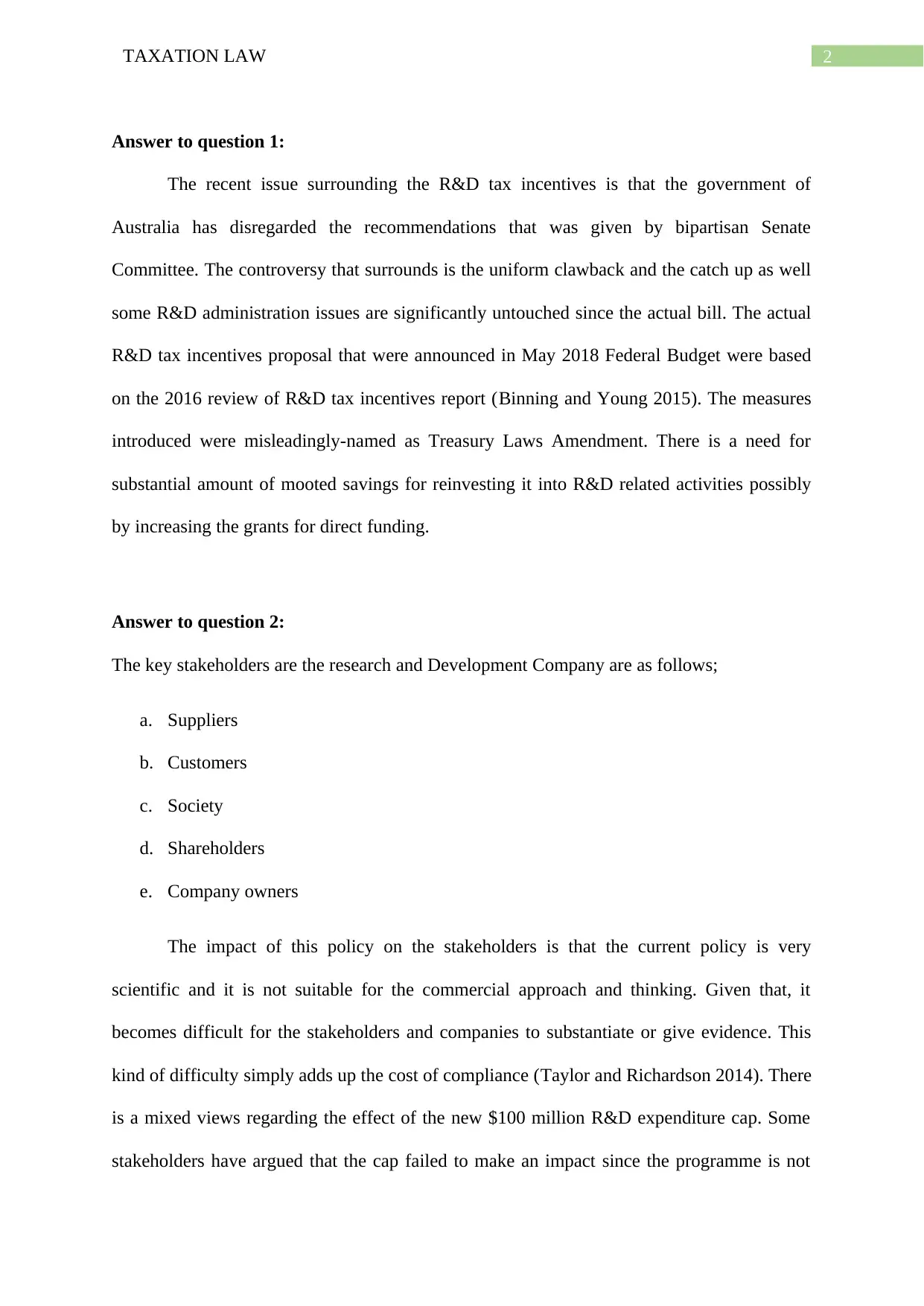
2TAXATION LAW
Answer to question 1:
The recent issue surrounding the R&D tax incentives is that the government of
Australia has disregarded the recommendations that was given by bipartisan Senate
Committee. The controversy that surrounds is the uniform clawback and the catch up as well
some R&D administration issues are significantly untouched since the actual bill. The actual
R&D tax incentives proposal that were announced in May 2018 Federal Budget were based
on the 2016 review of R&D tax incentives report (Binning and Young 2015). The measures
introduced were misleadingly-named as Treasury Laws Amendment. There is a need for
substantial amount of mooted savings for reinvesting it into R&D related activities possibly
by increasing the grants for direct funding.
Answer to question 2:
The key stakeholders are the research and Development Company are as follows;
a. Suppliers
b. Customers
c. Society
d. Shareholders
e. Company owners
The impact of this policy on the stakeholders is that the current policy is very
scientific and it is not suitable for the commercial approach and thinking. Given that, it
becomes difficult for the stakeholders and companies to substantiate or give evidence. This
kind of difficulty simply adds up the cost of compliance (Taylor and Richardson 2014). There
is a mixed views regarding the effect of the new $100 million R&D expenditure cap. Some
stakeholders have argued that the cap failed to make an impact since the programme is not
Answer to question 1:
The recent issue surrounding the R&D tax incentives is that the government of
Australia has disregarded the recommendations that was given by bipartisan Senate
Committee. The controversy that surrounds is the uniform clawback and the catch up as well
some R&D administration issues are significantly untouched since the actual bill. The actual
R&D tax incentives proposal that were announced in May 2018 Federal Budget were based
on the 2016 review of R&D tax incentives report (Binning and Young 2015). The measures
introduced were misleadingly-named as Treasury Laws Amendment. There is a need for
substantial amount of mooted savings for reinvesting it into R&D related activities possibly
by increasing the grants for direct funding.
Answer to question 2:
The key stakeholders are the research and Development Company are as follows;
a. Suppliers
b. Customers
c. Society
d. Shareholders
e. Company owners
The impact of this policy on the stakeholders is that the current policy is very
scientific and it is not suitable for the commercial approach and thinking. Given that, it
becomes difficult for the stakeholders and companies to substantiate or give evidence. This
kind of difficulty simply adds up the cost of compliance (Taylor and Richardson 2014). There
is a mixed views regarding the effect of the new $100 million R&D expenditure cap. Some
stakeholders have argued that the cap failed to make an impact since the programme is not
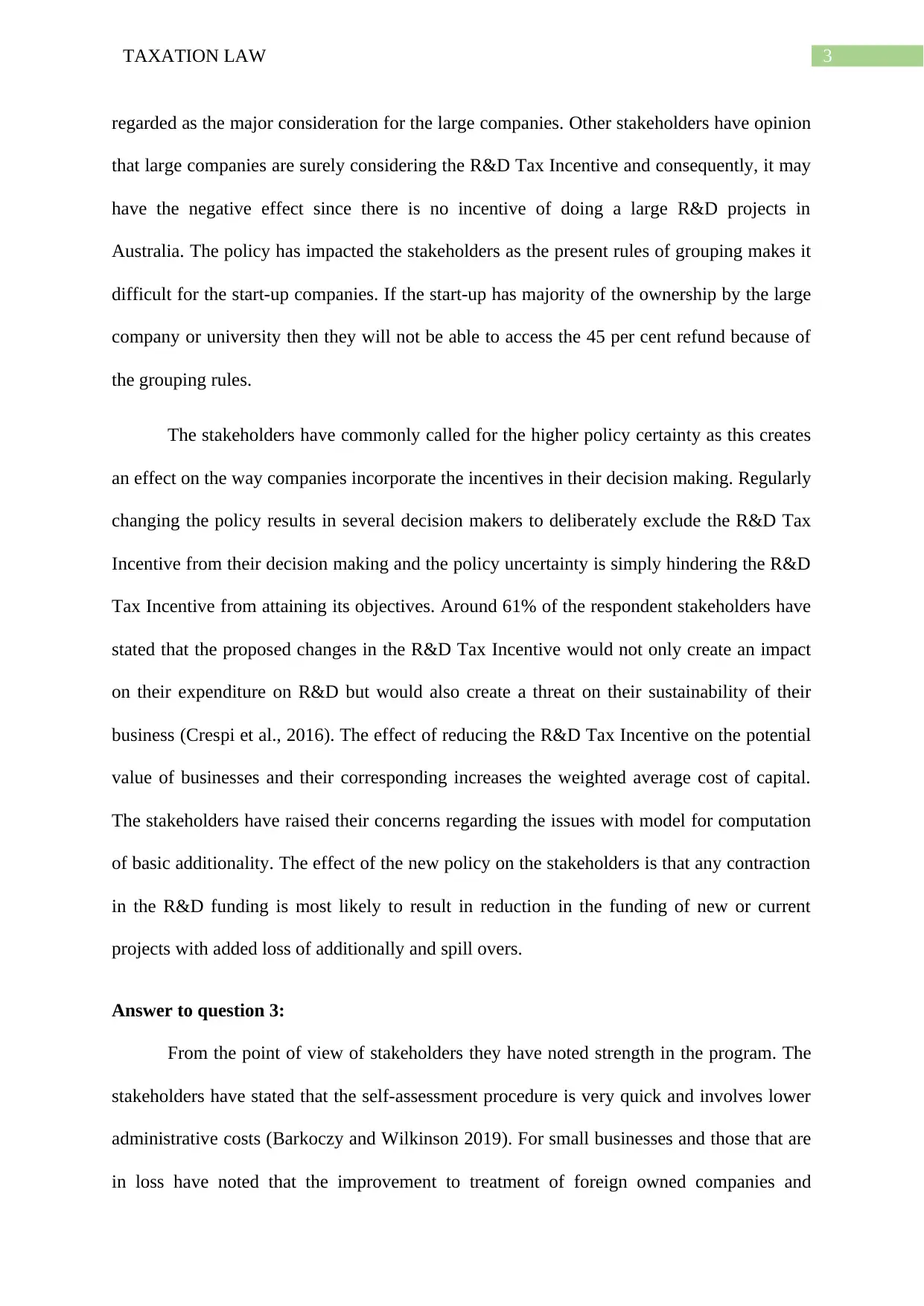
3TAXATION LAW
regarded as the major consideration for the large companies. Other stakeholders have opinion
that large companies are surely considering the R&D Tax Incentive and consequently, it may
have the negative effect since there is no incentive of doing a large R&D projects in
Australia. The policy has impacted the stakeholders as the present rules of grouping makes it
difficult for the start-up companies. If the start-up has majority of the ownership by the large
company or university then they will not be able to access the 45 per cent refund because of
the grouping rules.
The stakeholders have commonly called for the higher policy certainty as this creates
an effect on the way companies incorporate the incentives in their decision making. Regularly
changing the policy results in several decision makers to deliberately exclude the R&D Tax
Incentive from their decision making and the policy uncertainty is simply hindering the R&D
Tax Incentive from attaining its objectives. Around 61% of the respondent stakeholders have
stated that the proposed changes in the R&D Tax Incentive would not only create an impact
on their expenditure on R&D but would also create a threat on their sustainability of their
business (Crespi et al., 2016). The effect of reducing the R&D Tax Incentive on the potential
value of businesses and their corresponding increases the weighted average cost of capital.
The stakeholders have raised their concerns regarding the issues with model for computation
of basic additionality. The effect of the new policy on the stakeholders is that any contraction
in the R&D funding is most likely to result in reduction in the funding of new or current
projects with added loss of additionally and spill overs.
Answer to question 3:
From the point of view of stakeholders they have noted strength in the program. The
stakeholders have stated that the self-assessment procedure is very quick and involves lower
administrative costs (Barkoczy and Wilkinson 2019). For small businesses and those that are
in loss have noted that the improvement to treatment of foreign owned companies and
regarded as the major consideration for the large companies. Other stakeholders have opinion
that large companies are surely considering the R&D Tax Incentive and consequently, it may
have the negative effect since there is no incentive of doing a large R&D projects in
Australia. The policy has impacted the stakeholders as the present rules of grouping makes it
difficult for the start-up companies. If the start-up has majority of the ownership by the large
company or university then they will not be able to access the 45 per cent refund because of
the grouping rules.
The stakeholders have commonly called for the higher policy certainty as this creates
an effect on the way companies incorporate the incentives in their decision making. Regularly
changing the policy results in several decision makers to deliberately exclude the R&D Tax
Incentive from their decision making and the policy uncertainty is simply hindering the R&D
Tax Incentive from attaining its objectives. Around 61% of the respondent stakeholders have
stated that the proposed changes in the R&D Tax Incentive would not only create an impact
on their expenditure on R&D but would also create a threat on their sustainability of their
business (Crespi et al., 2016). The effect of reducing the R&D Tax Incentive on the potential
value of businesses and their corresponding increases the weighted average cost of capital.
The stakeholders have raised their concerns regarding the issues with model for computation
of basic additionality. The effect of the new policy on the stakeholders is that any contraction
in the R&D funding is most likely to result in reduction in the funding of new or current
projects with added loss of additionally and spill overs.
Answer to question 3:
From the point of view of stakeholders they have noted strength in the program. The
stakeholders have stated that the self-assessment procedure is very quick and involves lower
administrative costs (Barkoczy and Wilkinson 2019). For small businesses and those that are
in loss have noted that the improvement to treatment of foreign owned companies and
Secure Best Marks with AI Grader
Need help grading? Try our AI Grader for instant feedback on your assignments.
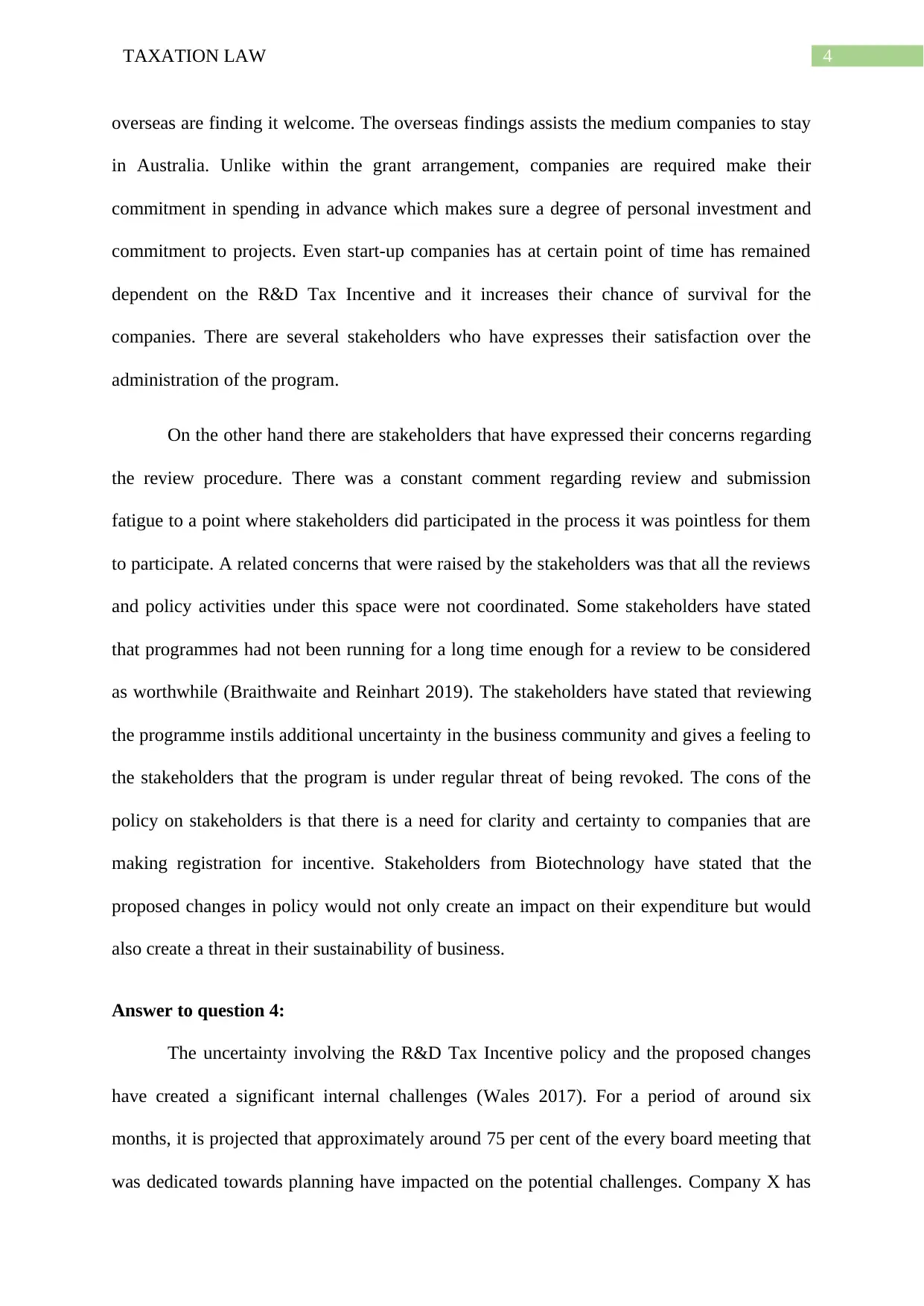
4TAXATION LAW
overseas are finding it welcome. The overseas findings assists the medium companies to stay
in Australia. Unlike within the grant arrangement, companies are required make their
commitment in spending in advance which makes sure a degree of personal investment and
commitment to projects. Even start-up companies has at certain point of time has remained
dependent on the R&D Tax Incentive and it increases their chance of survival for the
companies. There are several stakeholders who have expresses their satisfaction over the
administration of the program.
On the other hand there are stakeholders that have expressed their concerns regarding
the review procedure. There was a constant comment regarding review and submission
fatigue to a point where stakeholders did participated in the process it was pointless for them
to participate. A related concerns that were raised by the stakeholders was that all the reviews
and policy activities under this space were not coordinated. Some stakeholders have stated
that programmes had not been running for a long time enough for a review to be considered
as worthwhile (Braithwaite and Reinhart 2019). The stakeholders have stated that reviewing
the programme instils additional uncertainty in the business community and gives a feeling to
the stakeholders that the program is under regular threat of being revoked. The cons of the
policy on stakeholders is that there is a need for clarity and certainty to companies that are
making registration for incentive. Stakeholders from Biotechnology have stated that the
proposed changes in policy would not only create an impact on their expenditure but would
also create a threat in their sustainability of business.
Answer to question 4:
The uncertainty involving the R&D Tax Incentive policy and the proposed changes
have created a significant internal challenges (Wales 2017). For a period of around six
months, it is projected that approximately around 75 per cent of the every board meeting that
was dedicated towards planning have impacted on the potential challenges. Company X has
overseas are finding it welcome. The overseas findings assists the medium companies to stay
in Australia. Unlike within the grant arrangement, companies are required make their
commitment in spending in advance which makes sure a degree of personal investment and
commitment to projects. Even start-up companies has at certain point of time has remained
dependent on the R&D Tax Incentive and it increases their chance of survival for the
companies. There are several stakeholders who have expresses their satisfaction over the
administration of the program.
On the other hand there are stakeholders that have expressed their concerns regarding
the review procedure. There was a constant comment regarding review and submission
fatigue to a point where stakeholders did participated in the process it was pointless for them
to participate. A related concerns that were raised by the stakeholders was that all the reviews
and policy activities under this space were not coordinated. Some stakeholders have stated
that programmes had not been running for a long time enough for a review to be considered
as worthwhile (Braithwaite and Reinhart 2019). The stakeholders have stated that reviewing
the programme instils additional uncertainty in the business community and gives a feeling to
the stakeholders that the program is under regular threat of being revoked. The cons of the
policy on stakeholders is that there is a need for clarity and certainty to companies that are
making registration for incentive. Stakeholders from Biotechnology have stated that the
proposed changes in policy would not only create an impact on their expenditure but would
also create a threat in their sustainability of business.
Answer to question 4:
The uncertainty involving the R&D Tax Incentive policy and the proposed changes
have created a significant internal challenges (Wales 2017). For a period of around six
months, it is projected that approximately around 75 per cent of the every board meeting that
was dedicated towards planning have impacted on the potential challenges. Company X has
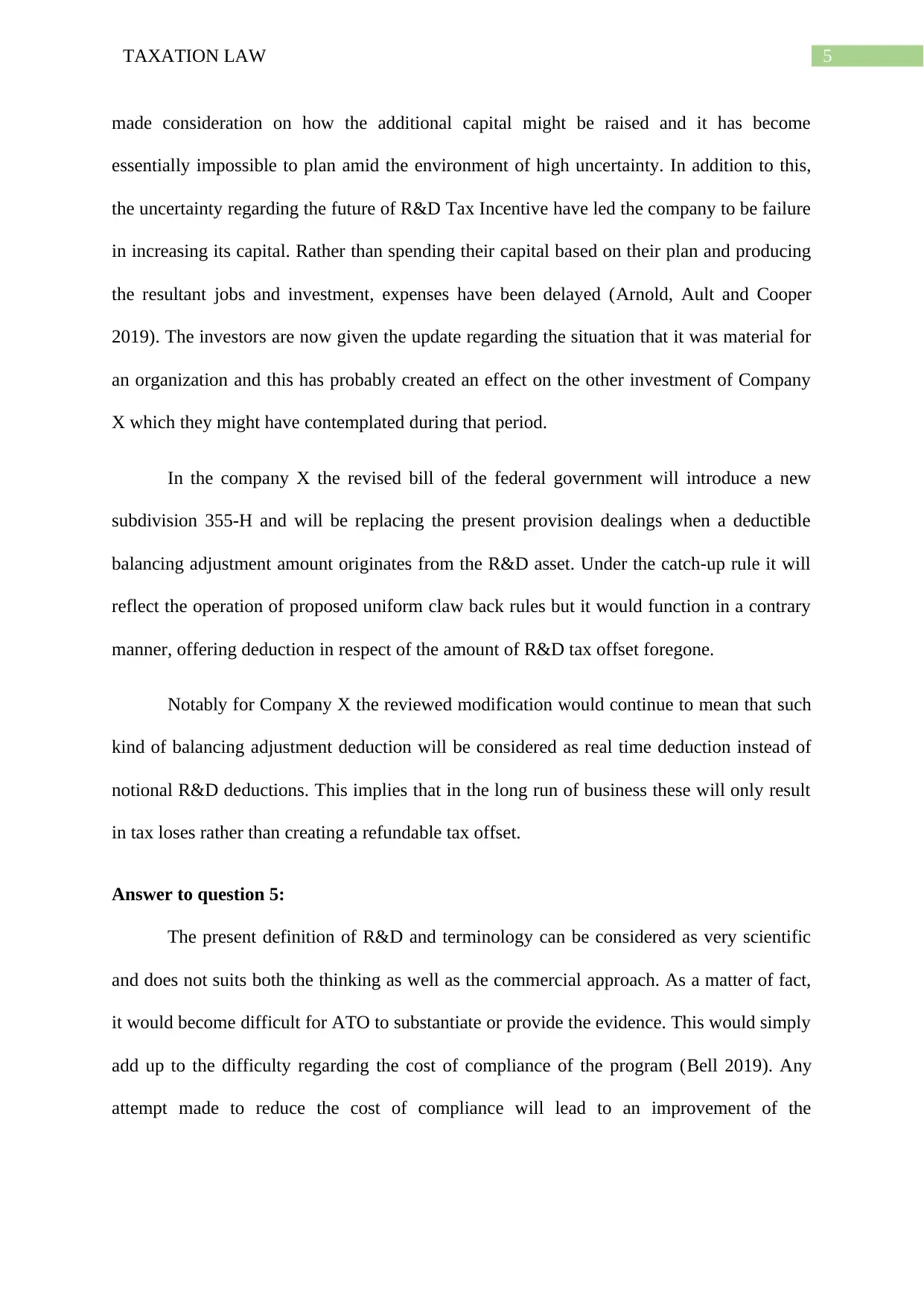
5TAXATION LAW
made consideration on how the additional capital might be raised and it has become
essentially impossible to plan amid the environment of high uncertainty. In addition to this,
the uncertainty regarding the future of R&D Tax Incentive have led the company to be failure
in increasing its capital. Rather than spending their capital based on their plan and producing
the resultant jobs and investment, expenses have been delayed (Arnold, Ault and Cooper
2019). The investors are now given the update regarding the situation that it was material for
an organization and this has probably created an effect on the other investment of Company
X which they might have contemplated during that period.
In the company X the revised bill of the federal government will introduce a new
subdivision 355-H and will be replacing the present provision dealings when a deductible
balancing adjustment amount originates from the R&D asset. Under the catch-up rule it will
reflect the operation of proposed uniform claw back rules but it would function in a contrary
manner, offering deduction in respect of the amount of R&D tax offset foregone.
Notably for Company X the reviewed modification would continue to mean that such
kind of balancing adjustment deduction will be considered as real time deduction instead of
notional R&D deductions. This implies that in the long run of business these will only result
in tax loses rather than creating a refundable tax offset.
Answer to question 5:
The present definition of R&D and terminology can be considered as very scientific
and does not suits both the thinking as well as the commercial approach. As a matter of fact,
it would become difficult for ATO to substantiate or provide the evidence. This would simply
add up to the difficulty regarding the cost of compliance of the program (Bell 2019). Any
attempt made to reduce the cost of compliance will lead to an improvement of the
made consideration on how the additional capital might be raised and it has become
essentially impossible to plan amid the environment of high uncertainty. In addition to this,
the uncertainty regarding the future of R&D Tax Incentive have led the company to be failure
in increasing its capital. Rather than spending their capital based on their plan and producing
the resultant jobs and investment, expenses have been delayed (Arnold, Ault and Cooper
2019). The investors are now given the update regarding the situation that it was material for
an organization and this has probably created an effect on the other investment of Company
X which they might have contemplated during that period.
In the company X the revised bill of the federal government will introduce a new
subdivision 355-H and will be replacing the present provision dealings when a deductible
balancing adjustment amount originates from the R&D asset. Under the catch-up rule it will
reflect the operation of proposed uniform claw back rules but it would function in a contrary
manner, offering deduction in respect of the amount of R&D tax offset foregone.
Notably for Company X the reviewed modification would continue to mean that such
kind of balancing adjustment deduction will be considered as real time deduction instead of
notional R&D deductions. This implies that in the long run of business these will only result
in tax loses rather than creating a refundable tax offset.
Answer to question 5:
The present definition of R&D and terminology can be considered as very scientific
and does not suits both the thinking as well as the commercial approach. As a matter of fact,
it would become difficult for ATO to substantiate or provide the evidence. This would simply
add up to the difficulty regarding the cost of compliance of the program (Bell 2019). Any
attempt made to reduce the cost of compliance will lead to an improvement of the
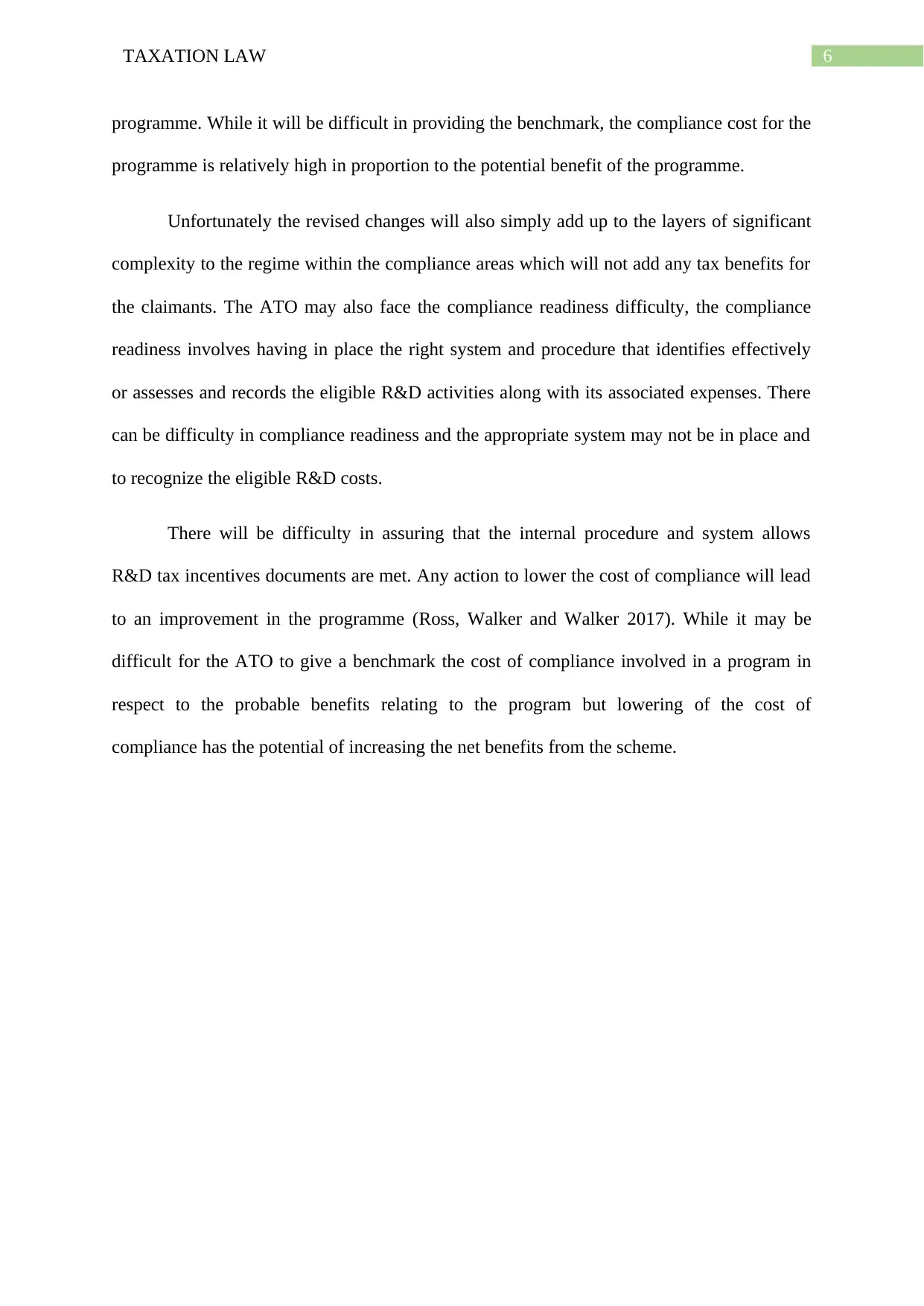
6TAXATION LAW
programme. While it will be difficult in providing the benchmark, the compliance cost for the
programme is relatively high in proportion to the potential benefit of the programme.
Unfortunately the revised changes will also simply add up to the layers of significant
complexity to the regime within the compliance areas which will not add any tax benefits for
the claimants. The ATO may also face the compliance readiness difficulty, the compliance
readiness involves having in place the right system and procedure that identifies effectively
or assesses and records the eligible R&D activities along with its associated expenses. There
can be difficulty in compliance readiness and the appropriate system may not be in place and
to recognize the eligible R&D costs.
There will be difficulty in assuring that the internal procedure and system allows
R&D tax incentives documents are met. Any action to lower the cost of compliance will lead
to an improvement in the programme (Ross, Walker and Walker 2017). While it may be
difficult for the ATO to give a benchmark the cost of compliance involved in a program in
respect to the probable benefits relating to the program but lowering of the cost of
compliance has the potential of increasing the net benefits from the scheme.
programme. While it will be difficult in providing the benchmark, the compliance cost for the
programme is relatively high in proportion to the potential benefit of the programme.
Unfortunately the revised changes will also simply add up to the layers of significant
complexity to the regime within the compliance areas which will not add any tax benefits for
the claimants. The ATO may also face the compliance readiness difficulty, the compliance
readiness involves having in place the right system and procedure that identifies effectively
or assesses and records the eligible R&D activities along with its associated expenses. There
can be difficulty in compliance readiness and the appropriate system may not be in place and
to recognize the eligible R&D costs.
There will be difficulty in assuring that the internal procedure and system allows
R&D tax incentives documents are met. Any action to lower the cost of compliance will lead
to an improvement in the programme (Ross, Walker and Walker 2017). While it may be
difficult for the ATO to give a benchmark the cost of compliance involved in a program in
respect to the probable benefits relating to the program but lowering of the cost of
compliance has the potential of increasing the net benefits from the scheme.
Paraphrase This Document
Need a fresh take? Get an instant paraphrase of this document with our AI Paraphraser
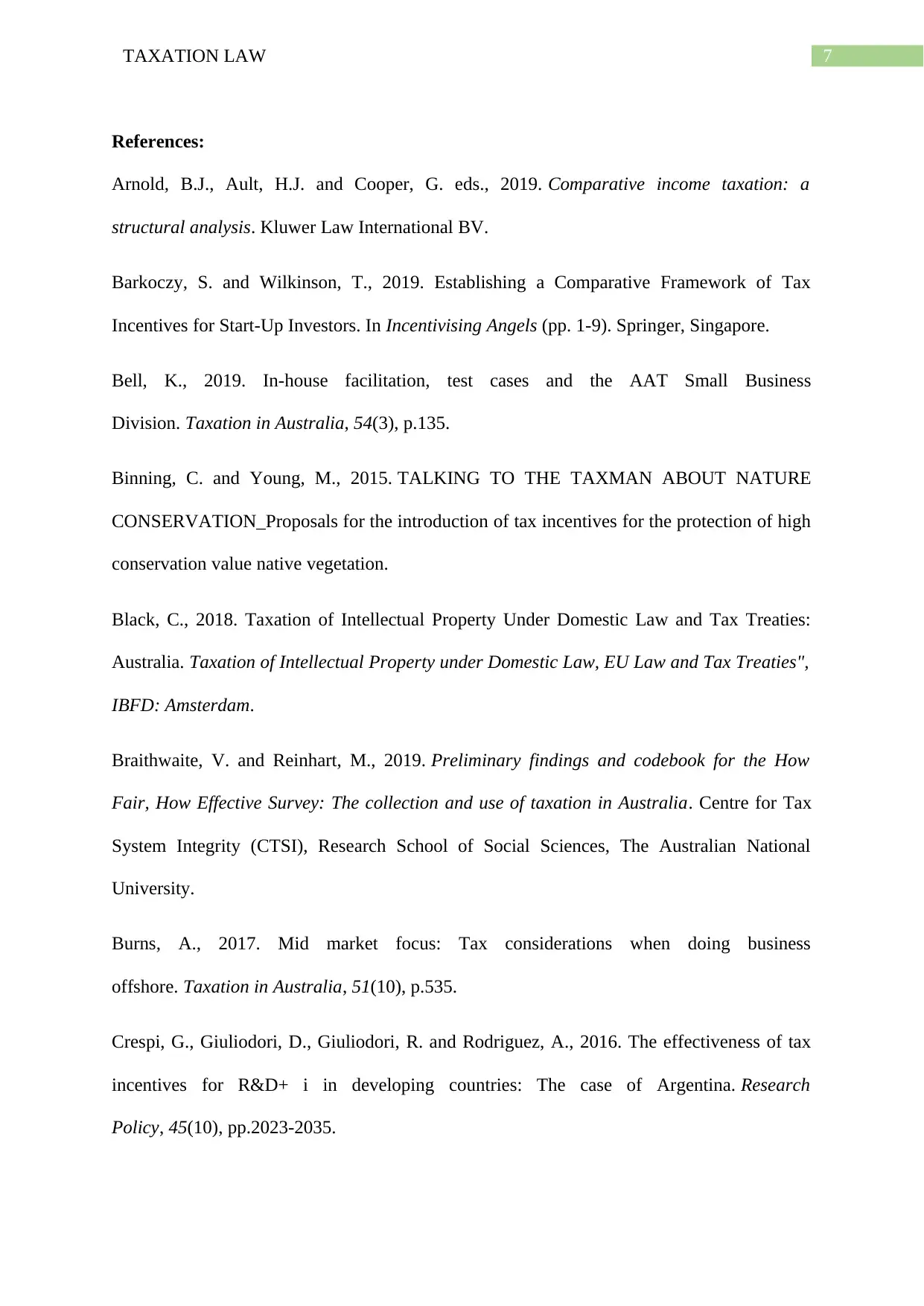
7TAXATION LAW
References:
Arnold, B.J., Ault, H.J. and Cooper, G. eds., 2019. Comparative income taxation: a
structural analysis. Kluwer Law International BV.
Barkoczy, S. and Wilkinson, T., 2019. Establishing a Comparative Framework of Tax
Incentives for Start-Up Investors. In Incentivising Angels (pp. 1-9). Springer, Singapore.
Bell, K., 2019. In-house facilitation, test cases and the AAT Small Business
Division. Taxation in Australia, 54(3), p.135.
Binning, C. and Young, M., 2015. TALKING TO THE TAXMAN ABOUT NATURE
CONSERVATION_Proposals for the introduction of tax incentives for the protection of high
conservation value native vegetation.
Black, C., 2018. Taxation of Intellectual Property Under Domestic Law and Tax Treaties:
Australia. Taxation of Intellectual Property under Domestic Law, EU Law and Tax Treaties",
IBFD: Amsterdam.
Braithwaite, V. and Reinhart, M., 2019. Preliminary findings and codebook for the How
Fair, How Effective Survey: The collection and use of taxation in Australia. Centre for Tax
System Integrity (CTSI), Research School of Social Sciences, The Australian National
University.
Burns, A., 2017. Mid market focus: Tax considerations when doing business
offshore. Taxation in Australia, 51(10), p.535.
Crespi, G., Giuliodori, D., Giuliodori, R. and Rodriguez, A., 2016. The effectiveness of tax
incentives for R&D+ i in developing countries: The case of Argentina. Research
Policy, 45(10), pp.2023-2035.
References:
Arnold, B.J., Ault, H.J. and Cooper, G. eds., 2019. Comparative income taxation: a
structural analysis. Kluwer Law International BV.
Barkoczy, S. and Wilkinson, T., 2019. Establishing a Comparative Framework of Tax
Incentives for Start-Up Investors. In Incentivising Angels (pp. 1-9). Springer, Singapore.
Bell, K., 2019. In-house facilitation, test cases and the AAT Small Business
Division. Taxation in Australia, 54(3), p.135.
Binning, C. and Young, M., 2015. TALKING TO THE TAXMAN ABOUT NATURE
CONSERVATION_Proposals for the introduction of tax incentives for the protection of high
conservation value native vegetation.
Black, C., 2018. Taxation of Intellectual Property Under Domestic Law and Tax Treaties:
Australia. Taxation of Intellectual Property under Domestic Law, EU Law and Tax Treaties",
IBFD: Amsterdam.
Braithwaite, V. and Reinhart, M., 2019. Preliminary findings and codebook for the How
Fair, How Effective Survey: The collection and use of taxation in Australia. Centre for Tax
System Integrity (CTSI), Research School of Social Sciences, The Australian National
University.
Burns, A., 2017. Mid market focus: Tax considerations when doing business
offshore. Taxation in Australia, 51(10), p.535.
Crespi, G., Giuliodori, D., Giuliodori, R. and Rodriguez, A., 2016. The effectiveness of tax
incentives for R&D+ i in developing countries: The case of Argentina. Research
Policy, 45(10), pp.2023-2035.
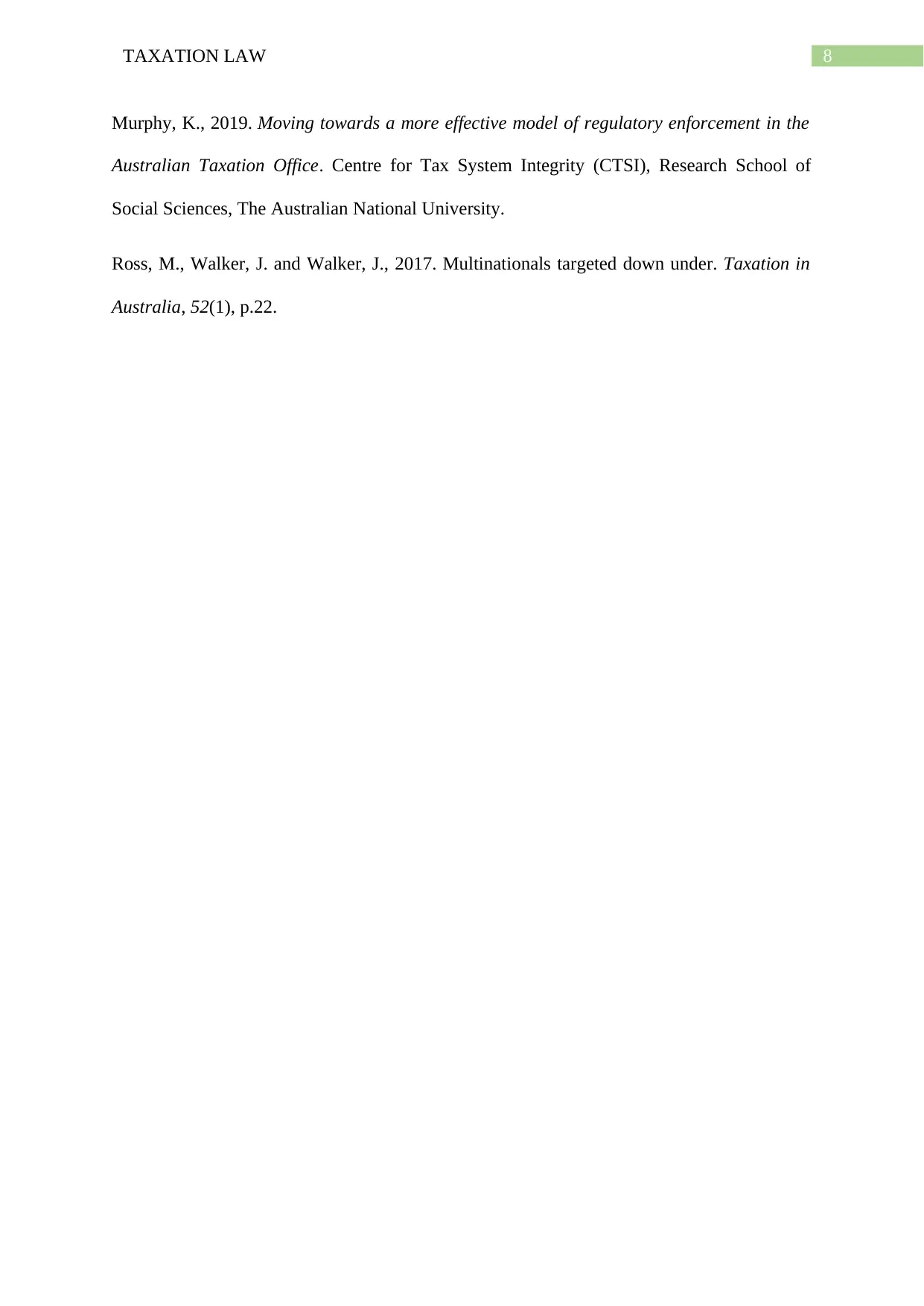
8TAXATION LAW
Murphy, K., 2019. Moving towards a more effective model of regulatory enforcement in the
Australian Taxation Office. Centre for Tax System Integrity (CTSI), Research School of
Social Sciences, The Australian National University.
Ross, M., Walker, J. and Walker, J., 2017. Multinationals targeted down under. Taxation in
Australia, 52(1), p.22.
Murphy, K., 2019. Moving towards a more effective model of regulatory enforcement in the
Australian Taxation Office. Centre for Tax System Integrity (CTSI), Research School of
Social Sciences, The Australian National University.
Ross, M., Walker, J. and Walker, J., 2017. Multinationals targeted down under. Taxation in
Australia, 52(1), p.22.
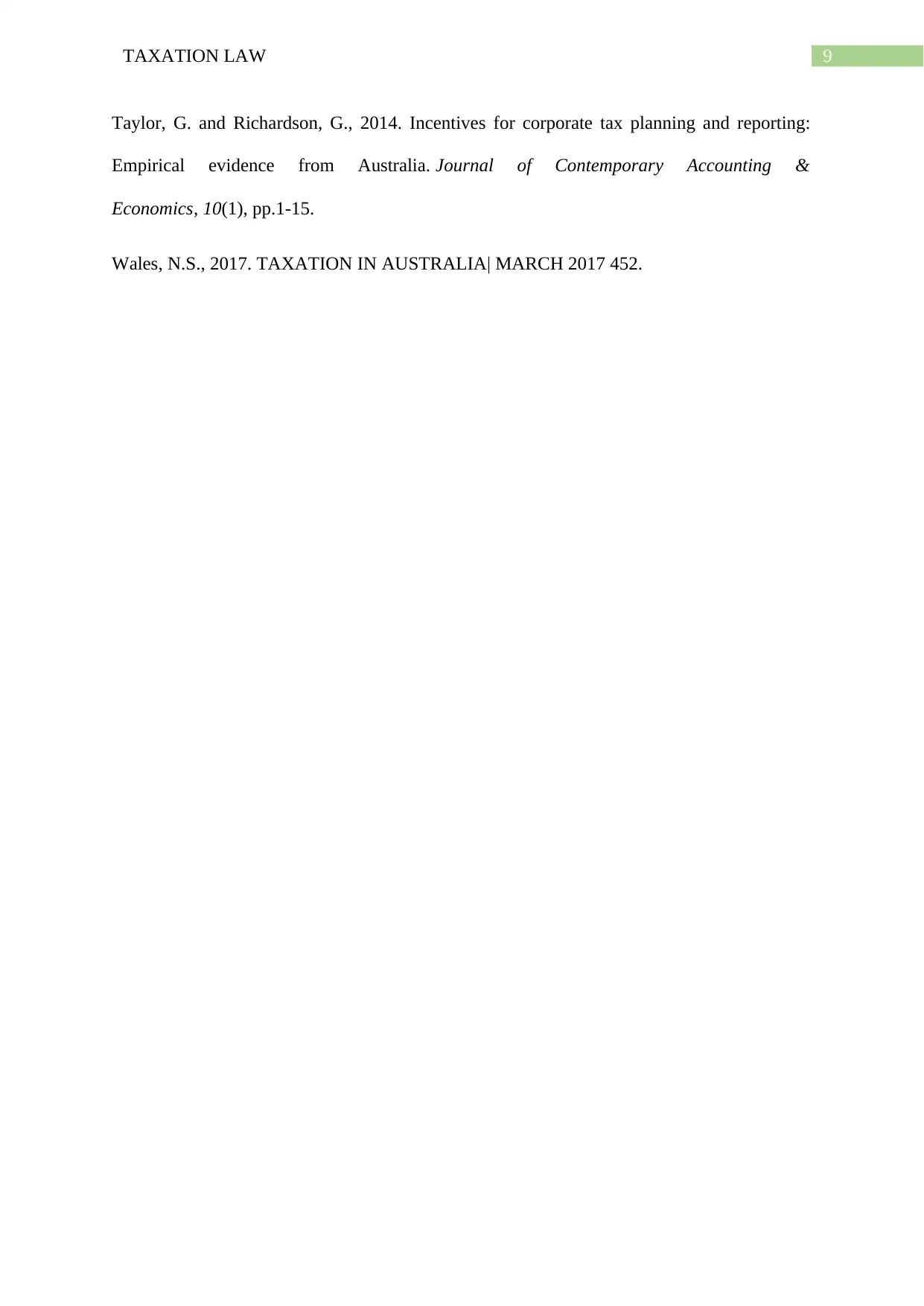
9TAXATION LAW
Taylor, G. and Richardson, G., 2014. Incentives for corporate tax planning and reporting:
Empirical evidence from Australia. Journal of Contemporary Accounting &
Economics, 10(1), pp.1-15.
Wales, N.S., 2017. TAXATION IN AUSTRALIA| MARCH 2017 452.
Taylor, G. and Richardson, G., 2014. Incentives for corporate tax planning and reporting:
Empirical evidence from Australia. Journal of Contemporary Accounting &
Economics, 10(1), pp.1-15.
Wales, N.S., 2017. TAXATION IN AUSTRALIA| MARCH 2017 452.
1 out of 10
Related Documents
Your All-in-One AI-Powered Toolkit for Academic Success.
+13062052269
info@desklib.com
Available 24*7 on WhatsApp / Email
![[object Object]](/_next/static/media/star-bottom.7253800d.svg)
Unlock your academic potential
© 2024 | Zucol Services PVT LTD | All rights reserved.




